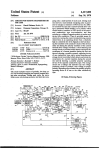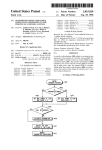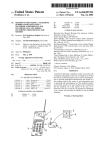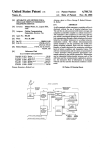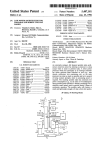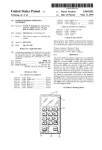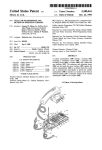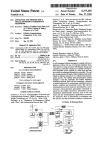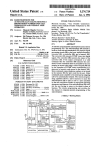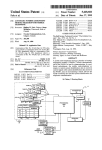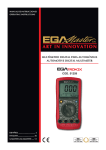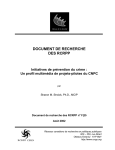Download llllllllllllllIIIlllllllllllllllllllllllllIllllllllllllllllllllllllllllllll
Transcript
llllllllllllllIIIlllllllllllllllllllllllllIllllllllllllllllllllllllllllllll USOO5l75759A United States Patent [19] [11] Patent Number: Metroka et a1. 145] Date of Patent: [54] COMMUNICATIONS DEVICE WITH FOREIGN PATENT DOCUMENTS MOVABLE ELEMENT CONTROL INTERFACE [76] 9010340 Inventors: Michael P. Metroka, 730 Oakview Dr., Algonquin, 111. 60102; Robert K. Krolopp, 6466 Cape Cod CL, Lisle, 111. 60532 Nov. 20, 1989 [51] Int. Cl.5 .......................................... .. H04M 11/00 [52] US. Cl. ...................................... .. 379/58; 379/61; 379/63; 455/89; 381/43 [58] 9/1990 PCT Int’l App]. ................. .. 379/58 OTHER PUBLICATIONS Motorola, “V. S. P. Hands-Free Operation Board”, 68P81048E93-A Jun. 15, 1983. Motorola, “Dyna-Tac 6000X”, 1984. Systcoms “Systcoms Classic Series”, Telephony Jan. [21] Appl. No.: 439,983 [22] Filed: 5,175,759 Dec. 29, 1992 Field of Search ................... .. 379/58, 63, 433, 62, 379/67, 56, 61; 362/24; 364/707; 455/90, 89, 73; Dl4/138; 340/825.44, 825, 825.36; 371/66; 381/43, 40, 110, 41 28, 1990. Realistic Owner’s Manual: Duofone ET—415 Cordless Electronic Telephone: Cat. #43-444: 1984. Motorola, Inc., User’s Manual #68P81121E820: Digital Voice Caller, Sep. 1988. Motorola, Inc. Manual #68P81115E38-D “VSP Hand s-Free Optics-Model T375A Series”, Nov. 5, 1985. Motorola, Inc. Manual #68P81117E63-O “VSP 11 References Cited Hands Free Option”, Model No. T944 Series Nov. 8, 1965. Panasonic KX-T300 Easa-Phone Cordless Phone FCC U.S. PATENT DOCUMENTS Transmitter Type Acceptance Filing Exhibits B, E, F [56] D. 300.742 4/1989 Soren et al. ..................... .. D14/l48 D. 304.189 10/1989 Nagele et al. .. D. 305,427 l/1990 3,476,886 ll/1969 3,551,607 12/1970 3,962,571 6/1976 4,018,998 4/1977 D14/l47 Soren et a1. ..................... .. D14/138 Ferrari et a1. . Tommasi et a1. . Brantingham ..................... .. 364/707 Wagner ........ .. Mallien .... .. 379/63 4,124,879 11/1978 Schoemer .... .. 362/24 4.471.493 Schober .. .. . . ... . . . . . . . . . . .. 379/61 4,477,807 10/1984 Nakajima et a1. . 4,680,787 6/1987 Marry 4.737.975 4/1988 Shafer .......... .. 4,797,929 l/l989 Gerson et a1. 381/43 4,845,772 4,870,686 7/1989 9/1989 Metroka et a]. ........ .. Gerson et a1. .......... .. 379/61 381/43 4.893.348 4,896.361 1/1990 Andoh ......... .. 455/89 1/1990 Gerson ......... .. 381/40 4,897,873 1/1990 Beutler et a1. . 379/433 ... .. . .. .. . . . .. . 4,933,963 6/1990 Sato et a1. 4,945,570 4,959.850 7/1990 9/1990 340/825.44 . . . . . . .. 379/58 381/110 379/58 4,961,212 10/1990 Marui et al. 379/67 5,023,911 6/1991 5,033,109 7/1991 Kawano et al. 455/90 5,048,117 9/1991 455/89 5,054,115 10/1991 .... .. .. . .. Aisaka et a1. .. 1990. Motorola, “Digital Hands Free Adapter for Personal Telephones", 1989. - . . . .. Primary Examiner-Curtis Kuntz Assistant Examiner—William Cumming Attorney, )lgent, 0r Firm-Raymond A. Jenski; Rolland R. Hackbart 379/63 379/58 Gerson ..... .. Marui ....... .. Gerson ment. Motorola, “Digital Hands Free Adapter Accessory", .. 379/370 4,122,304 10/1978 9/1984 Telecommunications Mar. 1990, Motorola Advertise 381/43 Sawa et a1. .......................... .. 455/89 [5 7] ABSTRACT A portable radiotelephone with a keypad, alphanumeric character display, and hands free function is disclosed. A movable ?ip element of the housing covers a keypad and other control buttons when in a closed, on-hook, position and activates the illumination of the keypad, enables the display, and enables the hands free function when in an open, off-hook, position. The duration of keypad illumination and display activation are timed to reduce battery drain and the hands free function may be deactivated with a hookswitch ?ash. 4 Claims, 8 Drawing Sheets US. Patent Dec. 29, 1992 Sheet 1 of 8 5,175,759 US. Patent Dec. 29, 1992 Sheet 3 of 8 5,175,759 US. Patent Dec. 29, 1992 Sheet 5 of 8 INTERRUPT FROM SLEEP STATE IS FLIP ELEMENT OPEN 702 704 2» YES READ KEYPAD 7“ YES ACT 0N KEY 4 [7 no NORMAL HOUSEKEEPING FUNCTIONS YE‘S 10 712 ' ENTER SLEEP STATE |.71s WAIT FOR INTERRUPT I’ 71a FIG.7A 5,175,759 US. Patent Dec. 29, 1992 Sheet 6 of 8 5,175,759 FIG.7B READ l HKS STATE 722 DIFFERENT FROM LAST NO TIME SEND OPEN FLIP COMMAND TO RADIO MICROCOMPUTER SEND CLOSED FLIP COMMAND TO RADIO MICROCOMPUTER NORMAL SLAVE [LP BACKGROUND FUNCTION 732 US. Patent Dec. 29, 1992 Sheet 7 of 8 5,175,759 802 NORMAL RADIO MICROCOMPUTER BACKGROUND FUNCTION ON TO OFF’ HOOK YES SWITCH TQRANSITION ACTIVATE VOICE RECOGNITION N0 83‘ ACTIVATE KEYPAD BACKLIGHT ANDDISPLAY; 835 TIME FOR 6 SECS; DEACTIVATE KEYPAD BACKLIGHT AND DISPLAY IS MUTE FUNCTION ON (.838 OFF To ON HOOK DEACTIVATE MUTE FUNCTION SWITCH TORANSITION 840 ' . NO A ‘ v | YES ANSWER CALL rm IS T CALL IN PROCESS 1; N° _ 7 law A TURN OFF VOICE RECOGNITION, BACKLIGHT ' AND DISPLAY FIG.8A E] US. Patent Dec. 29, 1992 Sheet 8 of 8 5,175,759 F I c .8 B Q] 814 IS TURN OFF VOICE RECOGNITION MUTE FUNCTION OQN START N MSEC. TIMER 315 818 HAS TIMER EXPIRED YES 820 , I 1 TERMINATE CALL NO 822 ON TO OFF HOOK No SWITCH TRANSITION ? HANDS FREE ADAPTOR NO 824 VOICE RECOGNITION ACTIVATED ? NO 826 W / SEND HOOK SWITCH FLASH DISABLE VOICE RECOGNITION 828 CURRENTLY IN HANDS FREE ? 8,32 I +-~ SWITCH TO HANDS YES SWITCH TO HANDSET MODE FREE MODE 830 I; 1 5,175,759 2 able ?ip element to control the illumination of the key pad. COMMUNICATIONS DEVICE WITH MOVABLE ELEMENT CONTROL INTERFACE It is a further object of the present invention to pro vide a portable radiotelephone which utilizes a movable ?ip element to control the activation and deactivation of the hands free function. It is a further object of the present invention to time BACKGROUND OF THE INVENTION The present invention is generally related to a porta Ible telephone apparatus, and more particularly to a cellular portable radiotelephone utilizing a movable the duration of the keypad illumination and display activation in order to conserve battery power. housing element to permit the user to answer and termi BRIEF DESCRIPTION OF THE DRAWINGS nate telephone calls and control various radiotelephone functions by opening or closing the movable element. FIG. 1 is an isometric drawing of a portable radiotele This invention is related to that disclosed and claimed in phone which may employ the present invention. US. patent application Ser. No. 439,993 ?led on Jun. 27, 1990 in behalf of Metroka, et al. Telephones having a rotary or pushbutton dial mech anism and other buttons integral to the handset portion have become commonplace in landline subscriber tele FIG. 2 is a side view of the portable radiotelephone of FIG. 1 depicting operation of the movable ?ip ele ment. FIG. 3 is a diagram of the hookswitch switch mecha nism which may be employed in the radiotelephone of phone instruments. This integral arrangement offers the FIG. 1. FIG. 4 is a block diagram of the electronic elements telephone user the convenience of bringing the user interface mechanism and control buttons close to the of a portable radiotelephone embodying the present invention. FIG. 5 is a schematic diagram of the slave microcom user. Radiotelephone operation, such as that offered in cellular radiotelephone or in cordless telephone sets, provide a mobility to the telephone user which landline telephone does not provide. The absence of a cord and the small size of the portable radiotelephone unit ena puter and associated circuitry employed in the portable radiotelephone of FIG. 4. FIGS. 6A_and 6B are block diagrams of the voice recognition circuitry and vehicular adaptor (hands-free) circuitry employed in the portable radiotelephone of bles the user to carry the unit essentially whereever the user goes. Recent innovations have enabled voice rec FIG. 4. FIGS. 7A and 7B are a ?owchart depicting the pro cess of hookswitch operation of the slave microproces ognition circuitry to be used with portable radiotele phones in order to provide the user the ability to dial sor. and control the operation of a portable radiotelephone with the spoken voice. Undesired operation of voice recognition circuitry in a radiotelephone setting, how FIGS. 8A and 8B are a flowchart depicting a process of interpreting hookswitch operation of the master mi ever, may turn the equipment on or off, cause transmis croprocessor. sion of unwanted signals and prevent use of a radio DETAILED DESCRIPTION OF THE PREFERRED EMBODIMENT A portable radiotelephone adapted to be used in a cellular radiotelephone system is shown in FIG. 1. This channel, or cause undesired functions to occur. Such undesired activation of voice recognition is likely to engage functions which reduce the operating life of the battery which powers the portable radiotelephone. portable unit consists of two readily apparent portions, a body portion 102 and a ?ip element portion 104. The drawing of FIG. 1 shows the ?ip element portion 104. Additional drain upon the battery of the radiotele phone is made by the apparatus providing illumination for the dial keypad and number display. Previously, in order to activate the portable telephone’s display, back The drawing of FIG. 1 shows the ?ip element 104 in an “open" position such that a user of the portable unit may listen via earpiece 106 and may speak into the microphone 107. The dial or keypad 110 consists of a plurality of buttons numbered one through zero, #, and lighting, or hands free function, the user would have to press a button which would initiate a function, digit, etc. The user would then have to press a clear button to delete this function or digit, Such an operation provides *, in a familiar telephone arrangement as well as addi an unwanted opportunity for error and may, for exam tional function buttons such as “send", “end", “clear”, “on-oft”, and other buttons associated with memory recall. Volume control buttons (not shown) may adjust the volume of the earpiece and/or the ringer. An alpha ple, have enabled the user to inadvertently erase the contents of the scratch pad memory used for dialing a call. A user, having experienced an undesired operation caused by an inappropriate press of a clear button, quickly becomes discouraged from using the otherwise useful illumination feature. SUMMARY OF THE INVENTION The present invention overcomes these problems by using the hookswitch in the movable ?ip element to activate the alphanumeric character display, backlight ing, and hands free function. Accordingly, it is one object of the present invention to provide a portable radiotelephone which utilizes a 55 numeric display 115 is disposed above the keypad 110. Operation of such a portable radiotelephone and ?ip element has been described in US. Pat. No. 4,845,772, assigned to the assignee of the present invention. When the ?ip element 104 is open as shown in FIG. 1, the portable cellular telephone can be in the state of 60 answering or making a telephone call. Such a state is commonly known as “off-hook”. (It should be noted that in a cellular preorigination dialing system an addi tional operator activity is required to place a call: upon entering a telephone number to be dialed either via the movable ?ip element to place the portable radiotele 65 keypad 110 or by recognition of digits or names by a phone in an on-hook or an off-hook condition. voice recognition circuit, the send button must be de It is another object of the present invention to pro pressed in order to activate the portable unit’s transmit vide a portable radiotelephone, which utilizes a mov ter and to complete the call. In the preferred embodi 3 5,175,759 ment, the send button may also be electronically acti vated by the voice recognition circuit and can be used to answer a call if the ?ip element is already open). Upon completion of the telephone call, the user may hang up the portable telephone (go “on-hook”) by mov ing the ?ip element 104 into a stowed position, that is, rotated about the axis of hinges 112 and 114 so that the ?ip element 104 rests nearly against keypad 110. This 4 functions (the slave microcomputer 414). The slave microcomputer 414 is shown in more detail in the sche matic of FIG. 5. The slave microcomputer 414 consists of a microprocessor 502 which, in the preferred em bodiment, is an MC68HCO5C4 microprocessor (which also has on-board memory). The basic function of the slave microprocessor is to provide interface to the user of the portable radiotelephone via keypad 110', display action activates a hookswitch (HKS) which causes the 416, and other buttons, indicators, and illumination telephone call to be terminated. Depression of the end button or an equivalent operation by the voice recogni tion circuit without closing the ?ip element may also to a multi-segment display 416 which, in the preferred embodiment, is a conventional LED eight digit display. terminate the call. Activation of the hookswitch occurs in the preferred embodiment when the angle between the body 102 and The slave microprocessor 502 is also coupled to a key pad matrix of buttons 110' which enables the portable radiotelephone user to input (dial)'telephone numbers, store and recall telephone number information, and the ?ip element 104 equals approximately 45°. The clos‘ ing of the ?ip element 104 can best be perceived in FIG. 2. The hookswitch in the preferred embodiment is lo cated between the ?ip element 104 and the body portion 102 and may be seen in the detail of FIG. 3. A contact 302 consisting of a conventional conductive spring ma terial is disposed in hinge 114 of ?ip element 104 and rotates with the ?ip element 104. A printed circuit board element 304 is disposed in the body portion 102 in a position such that the contact 302 presses against the circuit board element 304. Metallization disposed on printed circuit board element 304 is positioned such that when the ?ip element 104 is opened to an angle of 45°, backlighting. The slave microprocessor 502 is coupled perform other radiotelephone functions (such as initiate a telephone call). In the preferred embodiment, one of the keys 508 of the matrix 110' is specially dedicated to the function of turning the power on and off. Power on/off is accomplished by a momentary switch closure (by key 508) to ground which activates on/off circuitry. Volume increase switch 509 and volume decrease switch 511 are electrically coupled to the slave micro processor 502 as part of the row/column matrix. Their physical location is away from the keypad 110' to allow for greater user convenience. The function which is normally performed by a hook switch (HKS) in a conventional landline telephone is an electrical connection is completed between the met allization through the contact 302 to ground. In the 30 performed in the portable radiotelephone of the present invention as previously described in relation to FIG. 3. preferred embodiment, the combination of the contact The hookswitch is shown schematically as switch 306 in 302 and the printed circuit board element 304 is the FIG. 5. A DC (Direct Current) circuit is made or bro hookswitch (HKS) 306. ken by I-IKS 306 to ground and applied to microproces Referring to FIG. 4, there is illustrated an electrical block diagram of a cellular portable radiotelephone 35 sor 502. Furthermore, a pulse is generated from any embodying the present invention. Such a portable ra diotelephone includes a cellular radiotelephone trans change of state of the HKS 306 by a transistor 510 capacitors 512 and 514 and resistors 516, 518, and 519. The output of transistor 510 is taken from the collector ceiver 402 operable in cellular radiotelephone systems, and applied to the interrupt request (IRQ) input and the internal microphone 420 and switchable ampli?er 422, internal speaker 424 and switchable amplifier 426, radio 40 keypad column inputs of microprocessor 502 having a negative duration of approximately 10 microseconds. microcomputer 404 with conventional RAM (storing Microprocessor 502 stores the status of HKS 306 and pertinent cellular telephone call parameters) and con provides an indication of the change of state of HKS ventional ROM (storing control software), a power 306 to the radio microprocessor 404. controller 410 including regulators coupled to battery Communication between the slave microprocessor 430 for generating DC voltages for powering other blocks and coupled to on/off switch 408, a slave mi crocomputer 414 including conventional ROM with control software for controlling display 416 and keypad 110', a voice recognition circuit 432, and a vehicular adaptor (hands-free) circuit 450. Radio microcomputer 404, slave microcomputer 414, voice recognition circuit 502 and the radio microprocessor 404 is maintained on a data bus 415. This data bus 415 is coupled to the radio microcomputer 404 as shown in FIG. 4. Other functions also share the data bus 415 including the voice recogni 50 tion circuit 432 and the vehicular adaptor circuit 450. Assuming that the portable radiotelephone has been powered-up and the ?ip element has been opened to enable the HKS, a keypad 110' pushbutton activation by the portable radiotelephone user-results in a communi of a three-wire data bus 415, which operates as de scribed in U.S. Pat. Nos. 4,369,516 and 4,616,314 (incor 55 cation between the slave microprocessor 502 and the radio microcomputer 404 via the bus 415. The slave porated herein by reference).'The foregoing transceiver and microcomputer blocks may be conventional blocks . microprocessor 502, in the preferred embodiment, com 432, and vehicular adaptor (hands-free) circuit 450 are coupled to and communicate with one another by way of commercially available portable radiotelephones, municates that a closure has occurred between a partic ular row and a particular column corresponding to the such as, for example, the “MICROTAC PT" Cellular Telephone available from Motorola, Inc. The "M1 60 key pressed by the user. The radio microcomputer 404 may thentake the appropriate action, such as returning CROTAC PT” Cellular Telephone is described in fur a digit instruction via bus 415 for the slave microproces ther detail in operators manual no. 68P81l50E49, pub sor 502 to cause the display 416 to illuminate or other lished by and available from Motorola C & E Parts, wise display a character. Thus, the slave microproces 1313 East Algonquin Road, Schaumburg, Ill. 60196. In the preferred embodiment, two interconnected 65 sor 502 is commanded by the radio microprocessor 404 or the user in order to complete an assignment. microcomputer systems are utilized to control the basic Referring now to FIG. 6A, there is illustrated a block functions of the portable radiotelephone (the radio mi crocomputer 404) and to control the keypad and display , diagram of a voice recognition circuit 432 which may 5 5,175,759 6 be utilized in the present invention. When the voice If portable telephone is in the DHFA mode, audio recognition circuits are activated, microphone audio from an external microphone 454 is coupled to ampli?er 610 where the gain is increased to an appropriate input ampli?ers 422 and 426 are disabled and the transmitter (TX) audio 421 and receiver (RX) audio 425 are routed to the handsfree circuitry of the handsfree vehicular 612 digitizes the ampli?ed analog input signal from adaptor circuit 450 for processing and coupling to the hands~free microphone 454 and speaker 456, respec ampli?er 610. The digitized signal from A/D converter tively, as shown in FIG. 6B. 612 is fed to a ?lter bank 614 comprised of ‘n’ bandpass ?lters whose responses overlap at the 3dB response points. The output from each of the ?lter bank channels power via the external power source connection which level for the A/D converter 612. The A/D converter is fed to an ‘n’ channel energy detector 616 where the amplitude of the signal in each bandpass response is detected. The detected level from each energy detector, at 616, is fed to conventional microprocessor 618 for comparison with a stored energy template from mem ory 620. Upon successful correlation of the microphone input with the stored template, microprocessor 618 sends a command on the data bus 415 to the radio mi croprocessor 404. In this manner, a spoken command such as a telephone number to be dialed or a “send” or “end” command may be entered to control radiotele phone operation. Synthesized voice replies from the voice recognition circuits are initiated by microproces The portable cellular radiotelephone receives its is the output of conventional voltage regulator 642. The voltage supplied by vehicle battery 452 is voltage regu lated and controlled by voltage regulator 642. Control circuitry 644 turns the regulator output on and off in response to signals from the vehicle ignition input at port 646 and data bus 415. Data bus 415 is used by the portable radiotelephone to sense if a hands-free adaptor 450 is plugged into the portable radiotelephone. Re ceiver audio signal 425 from the portable radiotele phone is coupled to'ampli?er 648 in hands-free adaptor 450 to boost the level to drive speaker 456. The output from microphone 454 is connected to the portable ra diotelephone via TX audio connection 421. Illumination for the keypad 110 is provided, in the sor 618 by sending control signals to a random noise preferred embodiment, by a plurality of light emitting generator and pitch generator circuit 622. Signals from diodes (LEDs) indicated by diodes 536-541 in FIG. 5. LEDs 536-541 are conventionally supplied from bat these generators are fed to an ‘11’ channel ?lter bank 624 which comprises ‘n’ narrow bandpass ?lters. The out put of these ?lters are added together in a summer block 626 whose output is then fed to a D/A converter 628 where the digital signal is converted to an analog signal. This analog signal is ampli?ed to an appropriate level with ampli?er 630 and sent to the RX audio path 425 which is then sent to the external speaker 456 so that the tery+via current limiting resistors and switch transistor 543. Switch transistor 543 is coupled to the TCMP port of slave microprocessor 502 and is enabled/disabled in accordance with the stored program of slave micro processor 502. The LEDs are physically mounted be hind the keypad 110 shown in FIG. 1 and provide a backlighting to the keys to aid the user in selecting keys in dim lighting conditions. user will hear the synthesized voice responses. The Although the preferred embodiment has been imple voice recognition circuits may be activated and deacti 35 mented employing two microprocessors, this should vated by the radio microprocessor 404 by sending com not be a limitation of the invention for it is possible to mands to the voice recognition microprocessor 618 implement the present invention in a single micro over the data bus 415. Similar voice recognition circuits are further disclosed in US. Pat. Nos. 4,797,929; processor should the designer so desire. For either a 4,817,157; and 4,870,686, US. patent application Ser. Nos. 266,293 (“Word Spotting in a Speech Recognition System Without Predetermined Endpoint Detection” order to save battery power. ?led on behalf of Gerson on Oct. 31, 1988) now US. Pat. Nos. 5,023,911, 294,098 (“Digital Speech Coder Having Improved Vector Excitation Source” ?led on behalf of Gerson on Jan. 6, 1989) now US. Pat. Nos. 4,896,361, and 399,341 (“Method for Terminating a single microprocessor or a multiple microprocessor system, the microprocessors may be interrupt driven in Referring now to FIGS. 7A and 7B, processes fol lowed by the slave microcomputer 502 in realizing the 45 present invention are illustrated in ?owchart form. The process of FIG. 7A, therefore, commences with an interrupt due to a change of state of the hookswitch 306 to enable the microcomputer system at 702. A determi Telephone Call by Voice Command" ?led on behalf of nation is made, at 704, whether the ?ip element is open Gerson et al. on Aug. 25, 1989) now US. Pat. No. 4,945,570and International Publication Nos. 50 or closed. If the ?ip element is open, then the keypad 110 is read to determine which key has been closed at WO/87/07748 and WO 87/07749 Dec. 17, 1987). 706. If a key has been depressed, at 708, then the func Referring to FIG. 6B there is shown a block diagram tion or character designated by the key is acted upon at of a hands-free vehicular adaptor circuit which may be 710. If a keypad 110 key has not been depressed, then no employed in the present invention. The hands-free ve action is taken and the microcomputer system resumes hicular adaptor 450 may be a hands-free adaptor with regulated power supply which couples the portable radiotelephone to a vehicle battery 452. When coupled to duplex hands-free adaptor (DHFA), the portable radiotelephone is in the DHFA mode, in which, inter alia, display 416 is not disabled when the portable radio telephone is inactive for a predetermined time. Radio microcomputer 404 detects the presence of an external power source by monitoring an external power source signal from hands-free vehicular adaptor circuit its normal functions of controlling the transceiver, the display, and other housekeeping chores as shown at 712. If it is determined that the ?ip element is not open (at 704), then any keypad key depression is considered to be spurious and is ignored by progressing directly from the determination block at 704 to the normal housekeep ing functions block at 712. The entire process is re peated for a predetermined period of time until a deter mination is made that the microcomputer system should 450. The external power source signal is converted to a 65 go into a low power consumption mode as determined binary signal having a binary state indicating whether or not the external power source is present (i.e., binary zero state=external power source present). at 714. The microcomputer systerri is put into a "sleep" state at 716 and only the low power functions await for an interrupt signal at 718. 7 5,175,759 If the microcomputer system is implemented as a radio microcomputer and a slave microcomputer, the slave microprocessor 502 can send either a ?ip element closed indication or a ?ip open indication to the radio microcomputer, a detection of those indications is nec essary by the radio microcomputer. The slave micro processor. 502 determines, as part of its routine of chores, whether the hookswitch has changed state by comparing the current state against the stored state 722 and 724 of FIG. 7B. If the state is different, then a deter mination is made, at 726, whether the ?ip element is open or closed. If the ?ip element is determined to be open, then an open ?ip element command is transmitted to the radio microcomputer at 728. If the determination at 726 yields a closed ?ip element, then a closed ?ip element command is conveyed to the radio microcom puter at 730 and the slave microprocessor returns to its normal background functions at 732. In either case the 8 timer has expired. If the timer has expired then the ?ow proceeds to block 820 where the telephone call is termi nated. Thus, if the movable element is closed for longer than ‘n’ milliseconds while a call is in progress and the microphone is not muted, then the call is terminated. In the preferred embodiment, the timer duration ‘n’ is 1000 milliseconds. Flow proceeds from block 820 to 802 where ?ow returns to the normal background func tions. If it is determined, at 818, that the timer has not expired, then ?ow proceeds to determination block 822 where a test is made of whether an on-hook to off-hook transition has occurred. If no on-hook to off-hook tran sition has occurred, then ?ow returns to determination block 818. Flow continues in the 818—822 loop until either the timer expires or an on-hook to off-hook tran sition occurs. If a determination is made, at 822, that an on-hook to off-hook transition has occurred prior to the timer expiring, then ?ow proceeds to determination block 823. A test is made, at 823, of whether the tele radio microcomputer 404 maintains the ?ip element state in its associated storage and the slave microproces 20 phone is coupled to the hands-free vehicular adaptor circuit 450. One such vehicular adaptor circuit which sor 502, as part of its routine of chores, checks for a may be employed by the present invention is a S1757A keypad enable or a keypad disable command received available from Motorola, Inc., If the telephone is not from the radio microcomputer 404. Thus, if the ?ip coupled to the vehicular adaptor 450 then ?ow pro element is determined to be open, then the keys of the keypad are read in conventional fashion. If the ?ip 25 ceeds to a decision block, 824, where a determination of whether the voice recognition circuit has been enabled. element is determined to be closed, then the keys of the If the voice recognition circuit has been enabled, it is keypad are ignored. then disabled, at block 825, before the process returns to The process followed by the radio microcomputer the normal background functions at 802. If the voice 404 in realizing the present invention in the preferred embodiment is shown in FIGS. 8A and 8B. The radio 30 recognition circuit is not enabled at this time, then the process proceeds to block 826 where a hookswitch ?ash microprocessor 404, as part of its routine of chores, at signal is sent. Thus if the portable radiotelephone is 802, checks for a on-hook to off-hook transition at 804. coupled to the hands free vehicular adaptor 450 and is If an on-hook to off-hook transition has not occurred engaged in a telephone call when the hands free circuit then ?ow proceeds to determination block 806 where a test is made to determine if an off-hook to on-hook 35 of the vehicular adaptor is enabled, the momentary closure and reopening of the movable ?ip element (in transition has occurred. If none has occurred, then ?ow less than “n” msec.) deactivates the hands free function returns togthe normal background functions at 802. If it and the portable radiotelephone reverts to the use of the is determined that an off-hook to on-hook transition has internal microphone and speaker. Likewise, if the porta occurred at 806 indicating that the movable element 104 ble radiotelephone is coupled to the hands free adapter is in the closed position, then ?ow proceeds to determi 450 and engaged in a telephone call with the hands free nation block 808 where a test is made to determine if a circuit disabled, the momentary closure and reopening telephone call is presently in progress. If it is deter of the movable ?ip element results in the activation of mined that a call is not presently in progress, then ?ow the hands free circuit. If the portable radiotelephone is proceeds to 810 where the voice recognition circuitry is disabled, the backlighting is inactivated, and the display 45 not coupled to the hands-free vehicular adaptor 450 and is presently in a call 'with the microphone not muted is inactivated. Thus, if the movable ?ip element 104 is where the movable element is momentarily closed and closed while a call is not in progress, then the voice recognition circuitry, the backlighting, and the display then reopened prior to the timer expiring, then either are inactivated. Optionally, the display may remain activated for a period of six seconds before being deacti the voice recognition circuit is disabled or a hookswitch ?ash signal is sent. From 826, flow returns to the normal background functions at 802. If a determination is made, at 823, that the telephone was in the hands-free vehicular adaptor, then the pro cess ?ow continues to determination block 828. A test is 55 made, at 828, to determine whether the telephone is vated by such a off-hook to on-hook transition. From 810, ?ow returns to the normal background functions at 802. If a determination is made that a call was in progress, at 808, then ?ow proceeds to determination block 812. A test is made, at 812, of whether the micro phone mute function is on. If the microphone is muted, then ?ow proceeds to 814 where the voice recognition circuitry is disabled. Thus, when the movable element 104 is closed while a call is in progress and the micro phone is muted, the voice recognition circuitry is dis currently in the hands free “speakerphone”mode. If it is determined, at 828, that the telephone is not in the hands-free “speakerphone” mode, then the process ?ow proceeds to block 830 where the mode is set to the hands-free mode. In the hands-free mode, the internal microphone 420 and speaker 424 are inactivated and the external microphone 454 and external speaker 456 are abled. Flow proceeds from block 814 to 802 where ?ow returns to the normal background functions. If it is active. Thus, if the portable radiotelephone is in the determined, at 812, that the microphone is not muted, hands-free vehicle adaptor 450 and is presently in a call then ?ow proceeds to block 816 where a timer of ‘n’ milliseconds is started. This timer runs until it has either 65 ‘with the microphone not muted while the movable expired or the movable ?ip element is reopened. After the counter is started, ?ow proceeds to determination block 818 where a test is made to determine whether the element is momentarily closed and then re-opened prior to the timer expiring but is not in the hands-free mode at the time, then the mode is changed from a private call 9 5,175,759 with the radiotelephone’s internal microphone and speaker to the hands-free speakerphone mode using the external microphone and speaker-From 830, ?ow re 10 turns to the normal background functions at 802. If it is be taken as limited to the speci?c embodiment herein, and that changes and modifications may be made with out departing from the true spirit of the invention. It is contemplated therefore to cover the present invention, determined, at 828, that the portable radiotelephone and any and all such changes and modifications, by the was in the hands-free speakerphone mode then the flow appended claims. proceeds to block 832 where the mode is changed from the hands-free "speakerphone" mode to a private call We claim: 1. A radiotelephone apparatus having a portable unit using the radiotelephone’s internal microphone and speaker. Thus if the portable radiotelephone is in the position and a contracted position, and a decouplable hands-free vehicular adaptor 450 and is presently in a call with either microphone not muted while the mov comprising: with a movable housing element having an extended hands free apparatus, the radiotelephone apparatus able ?ip element 104 is momentarily closed and then reopened prior to the timer expiring and the radiotele means for producing an off-hook signal in the porta ble unit when the movable housing element is phone is in the hands-free mode at the time, then the placed in the extended position and for producing an on-hook signalin the portable unit when the movable housing element has been placed in the contracted position; mode is changed from the hands-free “speakerphone" mode to that of a private call using the radiotelephone‘s internal microphone 420 and speaker 424. From 832, ?ow returns to the normal background functions at 802. If it is determined, at 804, that an on-hook to off-hook ?rst means for detecting an occurrence of said on hook signal and a subsequent off-hook signal within a predetermined period of time; transition occurred then the flow proceeds to block 834 where the voice recognition circuitry 432 is activated. second means for detecting a coupling of the de couplable hands free apparatus to the portable unit; The process then, at 835, activates the keypad back lighting illumination and the display 416 for a conven tionally timed period of six seconds. Thus, if the radio and means, responsive to said ?rst means for detecting 25 microcomputer 404 is performing normal background and said second means for detecting, for activating functions and an on-hook to off-hook transition occurs, the decouplable hands free apparatus. then the voice recognition circuitry is activated, the keypad backlighting is activated, the display is acti 2. A radiotelephone apparatus in accordance with claim 1 further comprising means for- deactivating an vated. The ?ow continues to determination block 836. A test is made, at 836, to determine whether the micro phone mute function is on. If it is determined, at 836, activated decouplable hands free apparatus when said first means for detecting detects a second occurrence of said on-hook signal and a subsequent off-hook signal within a predetermined period of time. 3. A method of control of a decouplable hands free apparatus in a radiotelephone apparatus including a portable unit with a movable housing element having an will unmute the microphone, from 838 ?ow returns to extended position and a contracted position, the method the normal background functions at 802. comprising the steps of: If it is determined, at 836, that the microphone was producing an off-hook signal in the portable unit not muted, then ?ow proceeds to determination block 40 when the movable housing element is placed in the 840. A test is made, at 840, to determine whether the that the microphone is muted, then ?ow proceeds to block 838 where the microphone is unmuted. Thus if the microphone is in the muted state with the movable element 104 closed, Opening the movable element 104 extended position; portable radiotelephone is currently ringing. If it is producing an on-hook signal in the portable unit when the movable housing element has been determined, at 840, that the portable radiotelephone is not ringing, indicating that there is no incoming call, _ then the process ?ow returns to the normal background functions at 802. If it is determined, at 840, that the placed in the contracted position; detecting an occurrence of said on-hook signal and a radiotelephone is ringing, then the process ?ow pro ceeds to block 842 where the incoming call is answered. subsequent off-hook signal within a predetermined Thus, if the portable radiotelephone is ringing while the movable ?ip element 104 is closed and the movable ?ip element 104 is opened, the incoming call is answered. detecting a coupling of the decouplable hands free apparatus to the portable unit; and activating the decouplable hands free apparatus in response to said detection of said on-hook signal and subsequent off-hook signal within a predeter~ mined period of time and said detection of the coupling of the decouplable hands free apparatus to the portable unit. period of time; From 842, ?ow returns to the normal background func tions at 802. Thus, a portable radiotelephone having the capability of enabling and disabling hands free circuitry and en 55 abling and disabling number display and keypad illumi 4. A method in accordance with claim 3 further com nation in response to the position of a ?ip element has been shown and described. A ?ip element which covers a keypad and other control buttons when in a closed position also activates a hookswitch. While a particular embodiment of the invention has been shown and de scribed, it is to be understood that the invention is not to prising the step of deactivating an activated decouplable hands free apparatus in response to detection of a sec ond occurrence of said on-hook signal and a subsequent off-hook signal within a predetermined period of time. # 65 ‘I it It t














